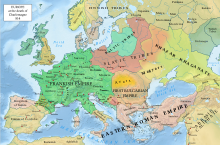Principality of Serbia (early medieval)
The Principality of Serbia (Modern Serbian: Кнежевина Србија / Kneževina Srbija) was one of the early medieval states of the Serbs, located in the western regions of Southeastern Europe.
[3] The main information of the history of the principality and Vlastimirović dynasty are recorded in the contemporary historical work De Administrando Imperio (written c.
[8] The history of the early medieval Serbian principality and the Vlastimirović dynasty is recorded in the work De Administrando Imperio (On the Governance of the Empire, abbr.
The work mentions the first Serbian ruler, without a name (known conventionally as "Unknown Archon"), that led the White Serbs to southeastern Europe and received the protection of Emperor Heraclius (r. 610–641), prior to the Bulgar invasion (680).
[14] According to DAI, "baptized Serbia" (known erroneously in historiography as Raška[15]), included the inhabited cities (καστρα/kastra) of Destinikon (Δεστινίκον), Tzernabouskeï (Τζερναβουσκέη), Megyretous (Μεγυρέτους), Dresneïk (Δρεσνεήκ), Lesnik (Λεσνήκ), and Salines (Σαληνές), while the "small land" (χοριον/chorion) of Bosnia (Βοσωνα), part of Serbia, had the cities of Katara (Κατερα) and Desnik (Δέσνηκ).
[19][20] Given the large territory, the Serbs most likely arrived as a small military elite which managed to organize and assimilate other already settled and more numerous Slavs.
[27] Višeslav was succeeded by his son Radoslav, then grandson Prosigoj,[13] and one of these two most likely ruled during the revolt of Ljudevit Posavski against the Franks (819–822);[28] according to Einhard's Royal Frankish Annals, written in 822, Ljudevit went from his seat at Sisak to the Serbs,[28] with Einhard mentioning that for the Serbs "is said to be holding a great part of Dalmatia" (ad Sorabos, quae natio magnam Dalmatiae partem obtinere dicitur).
Within this region, the Serbs settled only a small, isolated and mutually distant river valleys, karst fields and fertile basins.
Those patches of the territory had fertile land, suitable for the agriculture, while the barely accessible, some mountain regions remained uninhabited.
In 805 Krum conquered the Braničevci, Timočani and Obotrites, to the east of Serbia, and banished their tribal chiefs and replaced them with administrators appointed by the central government.
[33] In 815, the Bulgarians and Byzantines signed a 30-year peace treaty, but in 818, during the rule of Omurtag (814–836), the Braničevci and Timočani together with other tribes of the frontiers, revolted and seceded from Bulgaria because of an administrative reform that had deprived them much of their local authority.
[34] The Timočani left the society (association, alliance[35]) of the Bulgarian Empire, and sought, together with the Danubian Obotrites and Guduscani, protection from Holy Roman Emperor Louis the Pious (r. 813–840), and met him at his court at Herstal.
[35] The Timočani migrated into Frankish territory, somewhere in Lower Pannonia, and were last mentioned in 819, when they were persuaded by Ljudevit to join him in fighting the Franks.
[36][37] The Bulgarian Empire had a general policy of expansion in which they would first impose the payment of tribute on a neighboring people and the obligation of supplying military assistance in the form of an alliance (society), leaving them internal self-government and local rulers, and when the need for this kind of relationship expired, they would terminate the self-government of the said people and impose their direct and absolute power, integrating them fully into the Bulgarian political and cultural system.
It is not known whether Serbia at the time of Vlastimir had a fortification system and developed military structures with clearly defined roles of the župan.
After the victory over the Bulgars, Vlastimir's status rose, and according to Fine he went on to expand to the west, taking Bosnia, and Herzegovina (known as Hum).
[50][51] Mutimir maintained the communion with the Eastern Church (Constantinople) when Pope John VIII invited him to recognize the jurisdiction of the bishopric of Sirmium.
Peter secured himself on the throne (after fending off a challenge from Klonimir, son of Stojmir) and was recognized by Tsar Symeon I of Bulgaria.
He annexed the Bosna River valley, and then moved west securing allegiance from the Narentines, a fiercely independent, pirateering Slavic tribe.
However, Peter's expansion into Dalmatia brought him into conflict with Prince Michael of Zahumlje, who has also grown powerful, ruling the coastal Principality of Zachlumia.
Searching for allies against Bulgaria, the Byzantines showered Peter with gold and promises of greater independence if he would join their alliance - a convincing strategy.
Thus we see a continuous cycle of dynastic strife amongst Vlastimir's successors, stirred on by the Byzantine and Bulgarians, who were effectively using the Serbs as pawns.
After Tomislav's death, Croatia was in near-anarchy as his sons vied for sole rule, so Časlav was able to extend his domain north to the Vrbas river (gaining the allegiance of the chiefs of the various Bosnian župas).
[58] During this apogee of Serbian power, Christianity and culture penetrated Serbia, as the Serb prince lived in peaceful and cordial relations with the Byzantines.
Jovan Vladimir emerged later as a ruler of Duklja, a small territory centered in Bar on the Adriatic coast, as a Byzantine vassal.
Vladimir's pre-eminent position over other Slavic nobles in the area explains why Emperor Basil approached him for an anti-Bulgarian alliance.
In retaliation, Samuel invaded Duklja in 997, and pushed through Dalmatia up to the city of Zadar, incorporating Bosnia and Serbia into his realm.
[63] The DAI mentions that the Serbian throne is inherited by the son, i.e. the first-born; his descendants succeeded him, though their names are unknown until the coming of Višeslav.
[65] According to DAI, baptized Serbia included the following cities (καστρα/kastra),[66][67][68] with spellings used in Moravcsik's transcript (1967): By the beginning of the 7th century, Byzantine provincial and ecclesiastical order in the region was destroyed by invading Sclaveni and Pannonian Avars.
[87] The imperial charter of Basil II from 1020 to the Archbishopric of Ohrid, in which the rights and jurisdictions were established, mentions that the Episcopy of Ras belonged to the Bulgarian autocephal church during the time of Peter I (927–969) and Samuel of Bulgaria (977–1014).




